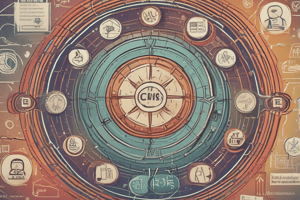Podcast
Questions and Answers
What are the two dimensions on which Balogun and Hope Hailey map the four types of change?
What are the two dimensions on which Balogun and Hope Hailey map the four types of change?
Scope and scale
What are the two dimensions on which organizational change can be mapped?
What are the two dimensions on which organizational change can be mapped?
Pace and scope
What are the four categories of change based on the dimensions identified by Plowman?
What are the four categories of change based on the dimensions identified by Plowman?
Driver of change, form of the change, nature of the change, types of connections in the system
What type of change is characterized by happening slowly and being channeled into improving systems and practices within an organization's template?
What type of change is characterized by happening slowly and being channeled into improving systems and practices within an organization's template?
Which type of change occurs more quickly, perhaps as a result of a specific shock or crisis, and is channeled by negative feedback to keep the organization's template in shape?
Which type of change occurs more quickly, perhaps as a result of a specific shock or crisis, and is channeled by negative feedback to keep the organization's template in shape?
What type of change happens quickly in response to a major shock or crisis?
What type of change happens quickly in response to a major shock or crisis?
What is the difference between convergent change and radical change?
What is the difference between convergent change and radical change?
According to Grundy's scale types, what does scale type 3 entail?
According to Grundy's scale types, what does scale type 3 entail?
What is the difference between planned change and emergent change?
What is the difference between planned change and emergent change?
What is the main characteristic of evolutionary change?
What is the main characteristic of evolutionary change?
What are the common change events mentioned in the text?
What are the common change events mentioned in the text?
How does change beget more change, according to the text?
How does change beget more change, according to the text?
What is the defining characteristic of scale type 4 according to Grundy's scale types?
What is the defining characteristic of scale type 4 according to Grundy's scale types?
What is the difference between continuous change and radical change?
What is the difference between continuous change and radical change?
What is the distinction between convergent change and evolutionary change?
What is the distinction between convergent change and evolutionary change?
What distinguishes planned change from radical change?
What distinguishes planned change from radical change?
What is the primary characteristic of emergent change?
What is the primary characteristic of emergent change?
What does radical change involve?
What does radical change involve?
Flashcards are hidden until you start studying
Study Notes
- The text discusses various types and concepts of organizational change.
- Change can be continuous and radical, arising from small adjustments that accumulate and lead to new templates being formed.
- Grundy's scale types describe different levels of change:
- Scale type 1: ongoing process of fine-tuning strategy, structure, people, and processes.
- Scale type 2: incremental adjustments to business strategies, structures, and management processes.
- Scale type 3: major realignment of one or more departments/divisions with a focus on radical change.
- Scale type 4: organizational-wide, radical shift in business strategy and revolutionary changes throughout.
- Convergent change refers to the adjustment of an existing organizational configuration without altering it.
- Planned change is deliberate and controlled, aiming to move an organization from one state to another.
- Evolutionary change is gradual adaptation of existing systems or structures.
- Revolutionary change is fast-paced and affects most or all of an organization at once.
- Radical change involves breaking away from an existing position and transforming an organization into a new template.
- Emergent change arises from experimentation and adaptation within an organizational system.
- Change begets more change, as organizations learn from their experiences and gain competencies to make further adjustments.
- Common change events include changes in markets, organizational leadership, and rules and routines.
- The more an organization changes, the more it learns and improves its ability to make changes effectively.
Studying That Suits You
Use AI to generate personalized quizzes and flashcards to suit your learning preferences.




